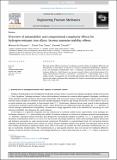Overview of metastability and compositional complexity effects for hydrogen-resistant iron alloys: Inverse austenite stability effects
Author(s)
Koyama, Motomichi; Tasan, Cemal Cem; Tsuzaki, Kaneaki
DownloadAccepted version (2.775Mb)
Publisher with Creative Commons License
Publisher with Creative Commons License
Creative Commons Attribution
Terms of use
Metadata
Show full item recordAbstract
© 2019 Elsevier Ltd The main factors affecting resistance to hydrogen-assisted cracking are hydrogen diffusivity and local ductility. In this context, we note fcc (γ) to hcp (ε) martensitic transformation, instead of γ to bcc (ά) martensitic transformation. The γ-ε martensitic transformation decreases the local hydrogen diffusivity, which thereby can increase strength without critical deterioration of hydrogen embrittlement resistance. Furthermore, ε-martensite in a high-entropy alloy is extraordinary ductile. Consequently, the metastable high-entropy alloys showed lower fatigue crack growth rates under a hydrogen effect compared with those of conventional metastable austenitic steels such as type 304.
Date issued
2019Department
Massachusetts Institute of Technology. Department of Materials Science and EngineeringJournal
Engineering Fracture Mechanics
Publisher
Elsevier BV